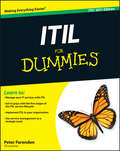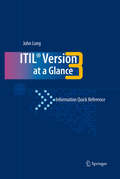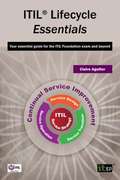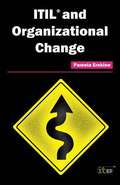- Table View
- List View
IT-gestütztes Ressourcen- und Energiemanagement: Konferenzband zu den 5. BUIS-Tagen
by Jorge Marx Gómez Volker Wohlgemuth Corinna LangIn diesem Tagungsband zu den 5. BUIS-Tagen (15. Tagung der Fachgruppe Betriebliche Umweltinformationssysteme der Gesellschaft für Informatik e.V.) werden aktuelle Themen des IT-gestützte Ressourcen- und Energiemanagements präsentiert mit dem Fokus auf: Green IT und Energieeffizienz, Stoffstrommanagement, Green Production, Green Logistics, Nachhaltigkeitsmanagement und Kommunikation, Green Software sowie Materialeffizienz und Recycling. In der "Students Corner" präsentieren Studierende eigene Lösungsansätze aus Projekten und Abschlußarbeiten.
ITC eChoupal Initiative
by David M. Upton Virginia A. FullerSoybean farmers in India have traditionally sold their product through ineffective and frequently dishonest physical marketplaces (mandi). Farmers are generally poor and often illiterate and are forced to be "price-takers" after an arduous journey to the mandi. They also have very limited access to information and education on farming techniques. Describes the use of Internet technologies to reach these farmers and, in particular, examines a new system called the eChoupal, developed by the Indian conglomerate ITC. The eChoupal has reengineered the antiquated soybean export supply chain using digital technology in rural farm villages. Based on a clever understanding of technology, sociology, and the incentives of the various players involved, the eChoupal provides farmers with effective methods of price discovery, honest trading, and information sharing to the benefit of all in the channel. Discusses the achievement, opportunities, and challenges of the managers of the new supply chain.
ITER: Bringing a Sun to Earth
by Michel ClaessensThis book provides for the first time an insider’s view into ITER, the biggest fusion reactor in the world, which is currently being constructed in southern France.Aimed at bringing the “energy of the stars” to earth, ITER is funded by the major economic powers (China, the EU, India, Japan, Korea, Russia and the US). Often presented as a “nuclear but green” energy source, fusion could play an important role in the future electricity supply. But as delays accumulate and budgets continue to grow, ITER is currently a star partially obscured by clouds. Will ITER save humanity by providing a clean, safe and limitless source of energy, or is it merely a political showcase of cutting-edge technology? Is ITER merely an ambitious research project and partly a PR initiative driven by some politically connected scientists? In any case, ITER has already helped spur on rival projects in the US, Canada and the UK. This book offers readers a behind-the-scenes look at this controversial project, which France snatched from Japan, and introduces them to a world of superlatives: with the largest magnets in the world, the biggest cryogenic plant and tremendous computing power, ITER is one of the most fascinating, and most international, scientific and technological endeavours of our time.
ITER: Bringing a Sun to Earth (Copernicus Books)
by Michel ClaessensThis book provides for the first time an insider’s view into ITER, the biggest fusion reactor in the world, which is currently being constructed in southern France. Now in its second edition, it updates readers on all developments at ITER and those at competing fusion initiatives worldwide, at the National Ignition Facility (US), the Joint European Torus (EU) and the tens of start-ups funded by private ventures. The author also shares his personal experience with this unique big science project.Aimed at bringing the “energy of the stars” to earth, ITER is funded by the major economic powers (China, the EU, India, Japan, Korea, Russia and the USA). Often presented as a “nuclear but green” energy source, fusion could play an important role in the future electricity supply. But as delays accumulate and budgets continue to grow, ITER is currently a star partially obscured by clouds. Will ITER save humanity by providing a clean, safe and limitless source of energy, or is it merely a political showcase of cutting-edge technology? Is ITER merely an ambitious research project and partly a PR initiative driven by some politically connected scientists? In any case, ITER has already helped spur on rival projects in the USA, Canada and the UK. This book offers readers a behind-the-scenes look at this controversial project, which France snatched from Japan, and introduces them to a world of superlatives: with the largest magnets in the world, the biggest cryogenic plant and tremendous computing power, ITER is one of the most fascinating, and most international, scientific and technological endeavours of our time.
ITIL For Dummies
by Peter FarendenITIL For Dummies provides an easy-to-understand introduction to using best practice guidance within IT service management. It breaks down the 5 stages of the service lifecycle into digestible chunks, helping you to ensure that customers receive the best possible IT experience. Whether readers need to identify their customers' needs, design and implement a new IT service, or monitor and improve an existing service, this official guide provides a support framework for IT-related activities and the interactions of IT technical personnel with business customers and users.Understanding how ITIL can help youGetting to grips with ITIL processes and the service lifecycleImplementing ITIL into your day to day workLearn key skills in planning and carrying out design and implementation projects
ITIL Version 3 at a Glance
by John O. LongITIL® Version 3 At a Glance takes a graphical approach to consolidating the information of ITIL® version 3. ITIL® is an internationally-recognized set of best practices for providing IT service management. IT organizations worldwide are implementing ITIL® as a vehicle for improving IT service quality and improve return on investment for IT services. The desk reference's unique graphical approach takes otherwise complex textual descriptions and makes the information accessible in a series of consistent, simple diagrams. ITIL® Version 3 At a Glance will be of interest to organizations looking to train their staffs in a consistent and cost-effective way. Further, this book is ideal for anyone involved in planning consulting, implementing, or testing an ITIL® Version 3 implementation.
ITIL® 2011 At a Glance
by John O. Long"ITIL® 2011 At a Glance" is an important update to the internationally-recognized ITIL® best practices for IT Service Management. "ITIL® 2011 At a Glance" provides graphical and textual memory joggers for the primary concepts of those best practices. IT organizations worldwide are implementing ITIL® as a vehicle for improving IT service quality and improve return on investment for IT services. This book is an update based on the ITIL 2011 Update. The desk reference's unique graphical approach will take otherwise complex textual descriptions and make the information accessible in a series of consistent, simple diagrams. "ITIL® 2011 At a Glance" will be of interest to organizations looking to train their staffs in a consistent and cost-effective way. Further, this book is ideal for anyone involved in planning consulting, implementing, or testing an ITIL® implementation.
ITIL® Lifecycle Essentials
by Claire AgutterTaking you through the ITIL Foundation exam and beyond. ITIL is the best practice methodology for IT Service Management, developed by the UK government and globally adopted in both the public and private sectors. ITIL Lifecycle Essentials covers all of the vital material required for the entry-level ITIL Foundation Certificate, which gives candidates a comprehensive overview of the key elements, concepts and terminology used in the ITIL service lifecycle. The essential link between your ITIL qualification and the real-world. More than just a guide to help you pass an exam, this book also provides practical guidance for when newly qualified practitioners enter the real-world. By addressing processes and concepts not covered in the syllabus, this book guides practitioners as they go beyond Foundation level. It features practical tips on using service management, and for each process the author adds to the theory with lessons from her own real-world experience. ITIL Lifecycle Essentials is ideal for self-study candidates, training delegates and V2 Foundation Certificate holders who have not yet taken the upgraded exam. Project managers looking to broaden their qualifications will find it a helpful companion to their studies and a practical aid for their professional development. Contractors or consultants with limited study time will also find this book essential to their part-time education. A perfect companion before, during and after your ITIL education. Claire Agutter has held a number of operational, consulting and implementation roles, giving her real-world, practical experience of ITIL. Since 2007 she has been an ITIL principal lecturer and has been involved in exam panels for ITIL V2 and V3. She has also provided online ITIL training to hundreds of successful Foundation delegates.
ITIL® and Organizational Change
by Pamela ErskineOrganizational change is difficult to manage and takes time to implement. How it is managed has a direct impact on its success. The implementation of ITIL can be particularly challenging, especially for organizations for whom it represents a radical change. So how do you ensure that the process goes smoothly and offers a return on your investment? In ITIL® and Organizational Change, Pamela Erskine analyzes some of the reasons why organizations fail to realize the benefits of ITIL and offers practical ways to avoid these pitfalls. She examines ways to clear the many hurdles that can obstruct progress and investigates how to improve acceptance of change in the workplace. Drawing on her many years of experience, Pamela discusses five different models of organizational change and explains how to select the most suitable approach for your project and your organization. Real-life examples bring the theories to life.
ITT Automotive: Global Manufacturing Strategy--1994
by Gary P. Pisano Sharon RossiITT Automotive is in the process of developing a new-generation antilock brake system (ABS), designated the MK-20. The case focuses on the level of automation to be used in the production of this new system, and whether all plants should use the same process technology. Due to intensifying cost pressure and rapidly growing demand for lower-cost ABS, the development team and senior management (based in Frankfurt, Germany) strongly favor using a single, highly automated production process in the four plants scheduled to produce the MK-20 (located in Germany, Belgium, and the United States). Managers at the company's two plants in the United States favor using less automation technology in order to allow greater flexibility for improving process technology over time.
Iacocca: An Autobiography
by Lee IacoccaHe's an American legend, a straight-shooting businessman who brought Chrysler back from the brink and in the process became a media celebrity, newsmaker, and a man many had urged to run for president.
Iacocca: An Autobiography (Economia Y Empresa Ser.)
by Lee Iacocca William NovakHe's an American legend, a straight-shooting businessman who brought Chrysler back from the brink and in the process became a media celebrity, newsmaker, and a man many had urged to run for president.The son of Italian immigrants, Lee Iacocca rose spectacularly through the ranks of Ford Motor Company to become its president, only to be toppled eight years later in a power play that should have shattered him. But Lee Iacocca didn't get mad, he got even. He led a battle for Chrysler's survival that made his name a symbol of integrity, know-how, and guts for millions of Americans.In his classic hard-hitting style, he tells us how he changed the automobile industry in the 1960s by creating the phenomenal Mustang. He goes behind the scenes for a look at Henry Ford's reign of intimidation and manipulation. He recounts the miraculous rebirth of Chrysler from near bankruptcy to repayment of its $1.2 billion government loan so early that Washington didn't know how to cash the check.From the Trade Paperback edition.
Ibrahim Dabdoub at the National Bank of Kuwait
by Linda A. Hill Dana M. TeppertIbrahim Dabdoub, the Group chief executive of the National Bank of Kuwait (NBK), reflects on his past 30 years at the helm of the Bank. Under his leadership, NBK grew from a small local bank to one of the preeminent financial institutions in the region. However, following the global financial crisis of 2008 and the Arab Spring, NBK had to slow its regional expansion. Dabdoub wonders if the Bank is positioned to thrive and fulfill its collective ambition to become the Arab regional bank by 2020.
Ice Cold Leader: Leading from the Inside Out
by Errol DoeblerThrive under any circumstances with insights from an elite combat veteran In Ice Cold Leader, special forces combat veteran, FBI agent, and business founder Errol Doebler reveals his unknown and silent battle with a traumatic brain injury incurred as a Navy SEAL in the late 1990s, and how he overcame emotional distress, self-doubt, depression, and anxiety to create a successful and happy personal and professional life until the day he discovered his pain was due to an injury he didn’t even know he had. Anchored in gripping tales from his time in the elite services, the author describes the unique process he created to not only survive but thrive in challenging situations. In this illuminating book, you’ll learn about: Interrupting negative patterns and replacing them with new, constructive patterns Developing tools to take on the stress of daily life without becoming overwhelmed by it Using cold exposure and breathing exercises to improve overall quality of life Structured yet flexible, Ice Cold Leader delivers a unique process to improve your daily state of mind, meet personal challenges as they arise, thrive under difficult circumstances, and live your best life possible.
Ice Cream Social: The Struggle for the Soul of Ben & Jerry's
by Brad EdmondsonBen & Jerry’s has always been committed to an insanely ambitious three-part mission: making the world’s best ice cream, supporting progressive causes, and sharing the company’s success with all stakeholders: employees, suppliers, distributors, customers, cows, everybody. But it hasn’t been easy. This is the first book to tell the full, inside story of the inspiring rise, tragic mistakes, devastating fall, determined recovery, and ongoing renewal of one of the most iconic mission-driven companies in the world. No previous book has focused so intently on the challenges presented by staying true to that mission. No other book has explained how the company came to be sold to corporate giant Unilever or how that relationship evolved to allow Ben & Jerry’s to pursue its mission on a much larger stage. Journalist Brad Edmondson tells the story with an eye for details, dramatic moments, and memorable characters. He interviewed dozens of key figures, particularly Jeff Furman, who helped Ben and Jerry write their first business plan in 1978 and became chairman of the board in 2010. It’s a funny, sad, surprising, and ultimately hopeful story.
Ice to the Eskimos
by Jon SpoelstraYou. That's Right. YOU. You've got a problem. You've got a product that's not first in its class. It's not even second. You've got to find a way to market that product. What Are You Going To Do? You're going to read this book, that's what. Let's face it. There comes a time in the life of every business when a product or service does not sell up to expectations. Maybe your product is outmoded. Or hasn't been positioned correctly. Or is competing in a crowded market. Whatever the reason, Ice to the Eskimos is dedicated to helping you reclaim that lost ground. It's about taking a product or service and turning it into a winner. If you've got a product that is not the best in its field, then you will love Ice to the Eskimos. Take the principles Jon Spoelstra writes about and run hard with them--you'll be amazed by the results. Written by the former president of the hapless New Jersey Nets, Jon Spoelstra is the man responsible for tripling that team's lagging revenues in just three years and increasing the season-ticket holders base by 250 percent. This guy knows what he's talking about. What everyone else had seen as a lost cause, Spoelstra saw as an outstanding opportunity to reawaken a tired and beaten product to achieve unprecedented profitability. Not just for sports marketers, this lively, entertaining book successfully makes the jump from sports to whatever your product may be. The techniques Spoelstra perfected while working for teams in the NHL and NBA--from innovative packaging to image overhaul--apply to any product in any company. The numerous winning examples are sure to make Ice to the Eskimos a must-read for anyone with a product or service to sell. Ice to the Eskimos is sure to be an instant marketing classic. It will show millions of readers how to market their product...sometimes even after they've given up hope. By using the powerful techniques in this book, you too can learn to achieve the impossible and market ice to the Eskimos.
Ice-Fili
by Michael G. Rukstad Sasha Mattu Asya PetinovaDesigned as an overview of all aspects of the strategy process: industry analysis, positioning, dynamics and sustainability, and scope issues of corporate strategy, including vertical integration, horizontal diversification, and location issues. Ice-Fili is the largest ice cream producer in Russia in 2002, but is facing strong competition from Nestle despite its success over other multinational competitors. Contains detailed exhibits, allowing deeper analyses.
Ice-Fili (Abridged)
by John R. Wells Pai-Ling Yin Michael G. RukstadDesigned as an overview of all aspects of the strategy process: industry analysis, positioning, dynamics and sustainability, and scope issues of corporate strategy, including vertical integration, horizontal diversification, and location issues. Ice-Fili is the largest ice cream producer in Russia in 2002, but is facing strong competition from Nestle despite its success over other multinational competitors. Contains detailed exhibits, allowing deeper analyses. A rewritten version of an earlier case.
Icebergs, Zombies, and the Ultra-Thin: Architecture and Capitalism in the 21st Century
by Matthew Soules"Soules's excellent book makes sense of the capitalist forces we all feel but cannot always name… Icebergs, Zombies, and the Ultra Thin arms architects and the general public with an essential understanding of how capitalism makes property. Required reading for those who think tomorrow can be different from today."— Jack Self, coeditor of Real Estates: Life Without DebtIn Icebergs, Zombies, and the Ultra Thin, Matthew Soules issues an indictment of how finance capitalism dramatically alters not only architectural forms but also the very nature of our cities and societies. We rarely consider architecture to be an important factor in contemporary economic and political debates, yet sparsely occupied ultra-thin "pencil towers" develop in our cities, functioning as speculative wealth storage for the superrich, and cavernous "iceberg" homes extend architectural assets many stories below street level. Meanwhile, communities around the globe are blighted by zombie and ghost urbanism, marked by unoccupied neighborhoods and abandoned housing developments.Learn how the use of architecture as an investment tool has accelerated in recent years, heightening inequality and contributing to worldwide financial instability:• See how investment imperatives shape what and how we build, changing the very structure of our communities• Delve into high-profile projects, like the luxury apartments of architect Rafael Viñoly's 432 Park Avenue• Understand the convergence of technology, finance, and spirituality, which together are configuring the financialized walls within which we eat, sleep, and workIncludes dozens of photos and drawings of architectural phenomena that have changed the way we live. Essential reading for anyone interested in architecture, design, economics, and understanding the way our world is formed.
Icebreaker: The China Entry Decision
by Dan Heath Joseph B. LassiterJeremy Moon, CEO of Icebreaker, maker of merino-fiber activewear, thinks about the strengths and weaknesses of staying focused on his rapidly expanding U.S. and European markets vs. broadening his attack to include China. If he enters China, should he continue his current strategy of pushing the technical merits of the merino fabric, or should he go the inherently subjective fashion route, given that the technical apparel market in China is virtually nonexistent.
Icebreaker: The China Entry Decision
by Dan Heath Joseph B. LassiterJeremy Moon, CEO of Icebreaker, maker of merino-fiber activewear, thinks about the strengths and weaknesses of staying focused on his rapidly expanding U.S. and European markets vs. broadening his attack to include China. If he enters China, should he continue his current strategy of pushing the technical merits of the merino fabric, or should he go the inherently subjective fashion route, given that the technical apparel market in China is virtually nonexistent.
Icebreaker: The US Entry Decision
by Dan Heath Joseph B. LassiterJeremy Moon, CEO of Icebreaker, merino wool, outdoor apparel manufacturer, believed the company could be a big hit in the United States, despite the presence of entrenched rivals. But Icebreaker clearly needed a new distribution approach. One option was to position Icebreaker as a brand selling fashionable sportswear. A second option was to mirror the strategy that had been effective in New Zealand--distributing through outdoor and snow sports retailers. A final option was to delay U.S. retail distribution and sell exclusively over the Internet, using direct-to-customer advertising.
Icebreaker: The US Entry Decision
by Dan Heath Joseph B. LassiterJeremy Moon, CEO of Icebreaker, merino wool, outdoor apparel manufacturer, believed the company could be a big hit in the United States, despite the presence of entrenched rivals. But Icebreaker clearly needed a new distribution approach. One option was to position Icebreaker as a brand selling fashionable sportswear. A second option was to mirror the strategy that had been effective in New Zealand--distributing through outdoor and snow sports retailers. A final option was to delay U.S. retail distribution and sell exclusively over the Internet, using direct-to-customer advertising.
Icedelights
by Michael J. RobertsThree second-year students at the Harvard Business School decide to buy a company. The case focuses on their thoughts about an entrepreneurial career, their search process, and the evaluation of an Icedelights (an ice cream/cafe) franchise. This is a rewritten version of an earlier case.
Iceland (A)
by Aldo MusacchioIn May of 2008, a team of sovereign debt analysts at Moody's had to decide whether to downgrade the country's sovereign long-term debt from Aaa to Aa1 or lower. Investor sentiment toward Iceland had changed radically in March, and the Moody's team was fearful that the situation could spiral out of control. The Moody's team knew that carry traders increased Iceland's vulnerability to a confidence crisis because they were quick to liquidate their holdings at the first sign of distress. The plunge in the Icelandic Krona since the beginning of 2008 also forced the Icelandic people to confront a decision: would joining the European Union (EU) protect Iceland from capricious swings in investor sentiment? What, if anything, should Iceland do to avoid a future crisis?













